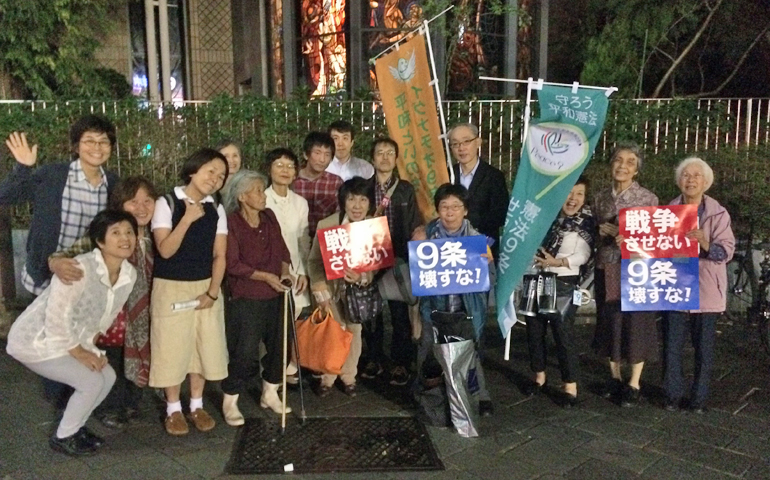
The Peace and Life Group of St. Ignatius Church, a Jesuit parish in Tokyo, Japan.
Editor's note: For the fall 2016 semester, David DeCosse is invited visiting professor at Sophia University, the Jesuit University in Tokyo. He is on the staff of the Markkula Center for Applied Ethics at Santa Clara University. He will be blogging about his experience abroad via the blog "Letters from Japan."
Japanese Constitution, Article 9: Aspiring sincerely to an international peace based on justice and order, the Japanese people forever renounce war as a sovereign right of the nation and the threat or use of force as means of settling international disputes.
In order to accomplish the aim of the preceding paragraph, land, sea, and air forces, as well as other war potential, will never be maintained. The right of belligerency of the state will not be recognized.
In May 1932 three Catholic students at the Jesuit-run Sophia University refused to bow in worship at Yasukuni Shrine, the Shinto memorial in central Tokyo for Japanese killed in war. In a time of rising fascist militarism, the incident provoked a sharp government protest. The archbishop of Tokyo soon produced a document that permitted bowing at the shrine as an appropriate display of patriotism. Of course, in the next decade Japan descended into the hell of aggressive war and atomic destruction.
The situation today in Japan is nowhere near as extreme as it was then. But today there are deep rumblings in Japanese politics — including a proposed change to Article 9, the so-called pacifist clause of the Japanese constitution — that are raising concerns about possibly fundamental and destructive changes to Japanese society and to the country's place in the world. And this time, the still tiny Japanese Catholic church — less than .5 percent of a total population of about 127 million people — is not going quietly into what may be a slowly darkening night.
That was the message reverberating from the bullhorn of the Peace and Life Group of St. Ignatius Church, as they demonstrated on the evening of Oct. 9, in opposition to any change to Article 9. Their tiny arc of candles on the sidewalk contesting the brilliant lights of the Tokyo night, the group chanted slogans and passed out pamphlets in the pedestrian-heavy space between the church and the rushing traffic on the wide street called Shinjuku-dori.
Jesuit Fr. Ichiro Mitsunobu, a leader of the Peace and Life Group and dean of the School of Theology at Sophia University, said Article 9 means "no war. … It's a great goal of all human beings." He added: "The spirit of Article 9 is dialogue, dialogue — not violence — as the solution to politics."
The plain language of Article 9, signaling the rejection of war, has captured the imagination of Christian pacifists around the world. In fact, the prevailing Japanese constitutional interpretation has held that the article permits the country to defend itself so long as an act of aggression is confirmed and dialogue has failed. The changes to the article proposed by Prime Minister Shinzo Abe's Liberal Democratic Party would primarily allow the country to engage in collective self-defense and to re-brand its Self Defense Forces as a more proactive military.
Beyond even sizeable Liberal Democratic Party majorities in the Japanese Diet, Abe has powerful factors working in his favor. There is fear of nuclear-armed North Korea's missiles, which are easily capable of reaching Japan even if their accuracy is suspect. Moreover, China's aggressive eastward push onto disputed offshore islands threatens shipping lanes crucial to Japanese prosperity (and the push shows no signs of abating: by 2049, the Chinese navy aims to have a presence in the Hawaiian Islands). The United States government would like the Japanese military to assume more responsibility for regional security. And the Japanese navy is already the fifth-largest in the world — so changing Article 9 to allow for a more proactive military has the appearance of legitimizing the existence of what is already a very sizeable force.
But with the Abe government and Article 9, what is on the surface is a portent for what appear to be even more dramatic changes running deep. "Who is Abe-San?" Mitsunobu asked. "We cannot understand his identify." In 2012 the Liberal Democratic Party proposed a complete rewrite of the Japanese constitution, which was drafted by postwar American occupation experts and approved in 1946 by the Japanese legislature and Emperor Hirohito. Changes to Article 9 were part of the Liberal Democratic Party proposal.
But so were a wide range of other possibly fundamental changes to the liberal democratic Japanese state, including: removal of democratic language emphasizing that the authority of the state derives from the will of the "people"; replacement of language affirming that "laws of political morality are universal" (read: universal human rights) with language subordinating rights to Japanese cultural traditions; and language diminishing the non-confessional status of the Japanese state by calling for direct government participation in Shinto rituals. "The entire package looks really ominous," said Professor Koichi Nakano of Sophia's political science department.
In the summer of 2015, the Liberal Democratic Party rushed security laws through the Diet that re-interpreted Article 9 without going through the process of constitutional revision. In a letter to Abe denouncing the move, Bishop Taiji Matsuya, chairman of the Japanese Catholic Council of Justice and Peace, used remarkably blunt language resonant with concern for an undemocratic legislative maneuver and for foreboding possibilities lying ahead. "This nation's legal framework, constitutionalism, will be destroyed by enacting these bills," the bishop wrote, "which neglects the Constitution and puts in place the exercise of a right to collective self defense. Moreover, these bills provoke hostility by heightening tension among nations, impel people to wage wars and open the way to dictatorship."
Even given large Liberal Democratic Party majorities in the Diet, the opposition to changing Article 9 remains strong, said Nakano. Among other reasons, the article remains popular as a distinctive sign of a people's commitment to peace forged from the bitterness of war.
The debate within Japan over fundamental matters of war, peace, democracy, human rights, and religion will play out in the next years. And Yasukuni Shrine will surely play a significant public role as a symbol of intersecting passions about all of these things. On a lovely October morning, with leaves showing the first signs of fall colors, visitors young and old bowed in worship at the shrine as brightly vested Shinto priests chanted in an inner sanctum under a vast pagoda. A sign on the grounds explains that "worshiping the souls of war heroes at Shinto shrines, as protectors of our nation, is a tradition that reflects beliefs of the Japanese people, past and present."
But at the shrine's museum, the line is easily crossed between reverence for the lost and revisionist history. On placards in many exhibits, reasonable arguments for the damaging role of Western colonialism in East Asian history become excuses absolving Japanese aggression in the Pacific War (as World War II is often called here). Without irony, one placard rewrites the story of Japanese wartime brutality by saying that postwar Asian movements for self-determination arose "once the desire for independence had been kindled under Japanese occupation."
In a paper published in the summer of 2016, Mitsunobu took aim at the combustible mix of religion, nationalism, and war evident at Yasukuni.* "It now seems a very important issue for Japanese society that its people realize the crippling effect of the unconscious tie of the influence of State Shinto, which plunders our passion for religion," he wrote. "When the Japanese become aware of the unhealthy relationship between religion and political power which has dominated its history then, and only then, will people be able to transform the powerlessness of religion so that the true image of the God of Jesus Christ may truly flourish."
In their efforts for peace, however, Mitsunobu, the Peace and Life Group, and others have an ally in a high place — Emperor Akihito. The Liberal Democratic Party wants to yoke the emperor to its revisionist project. But he isn't playing along. He speaks often of peace and has praised the current constitution. In Shinto mythology, he is considered of divine ancestry.
But, in an August address to the nation, the 82-year-old "symbol of the state and of the unity of the people" mused on his mortality and his possible abdication — a blow to a right-wing hankering to join the numinous power of his office to their nationalist plans. Prime Minister Abe and other government leaders have made a point of appearing at Yasukuni. Enthroned since 1989, Emperor Akihito has never visited the shrine — a short walk from the Imperial Palace.
*This story has been updated to clarify a sentence.
[David DeCosse serves the staff of the Markkula Center for Applied Ethics at Santa Clara University.]
